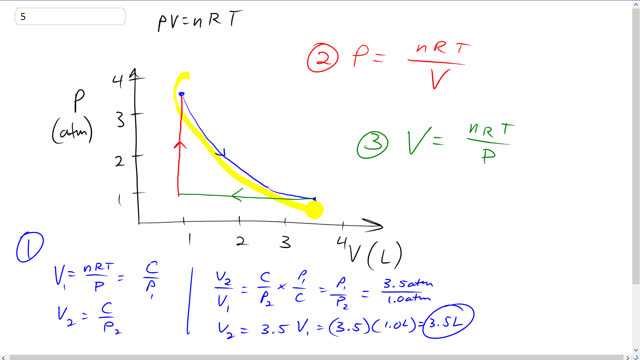
A 1.0-L volume of air initially at 3.5 atm of (gauge) pressure is allowed to expand isothermally until the pressure is 1.0 atm. It is then compressed at constant pressure to its initial volume, and lastly is brought back to its original pressure by heating at constant volume. Draw the process on a PV diagram, including numbers and labels for the axes.

In order to watch this solution you need to have a subscription.
This is Giancoli Answers with Mr. Dychko. We have a one liter volume of gas initially at three and a half atmospheres of pressure and then we're gonna draw the Isothermic transition to a pressure of one atmosphere and we need to calculate what this volume is gonna be. So that's what I'm showing in blue here. This blue calculation corresponds to the blue section of this P V diagram and this green corresponds to this, and then the red corresponds to the red and happens in the order of one, two, three. So let's calculate this volume here. Turns out to be three and a half liters and we know that because the Volume One is nRT over P, when you rearrange the ideal gas law you get V is moles times gas constant times temperature divided by pressure. And we're told that the temperature is constant, which means this entire numerator is constant. Since this is Isothermic and isothermic means constant temperature. So with this being a constant on top, as pressure decreases then volume will be increasing. So as the denominator of a fraction gets smaller, the fraction itself, the quotient becomes bigger. So if you compare, you know, one half to one eighth, when you decrease the denominator, you increase the fraction so one half is a bigger quantity than one eighth. So this volume at the beginning, Volume One is some constant divided by Pressure One, three and a half. As it turns out, and then Volume Two is going to be the same constant because it's the same temperature, the same number of moles. It's a sealed container. So same constant divided by a new pressure P2. And if you're V2 divided by V1, you have the constant divided by P2. That's would be one is sorry V2 I should say the V2 is C over P2 and then we're gonna divide that by V1, which is the same as multiplying by the reciprocal of V1 P1 over C and the C is canceled leaving us with P1 over P2. So V2 to over V1 is P1 over P2. So that's three and a half atmospheres of pressure one divided by one atmosphere at this pressure two this final pressure. So that works out to three and a half. So V2 is three and a half times V1. Multiply this by V1, multiply this by V1 and you get this line here. So V2 is three and a half times V1. So that's three and a half times one liter which is three and a half liters. And so that helps us know how to number this x-axis so that this final point here ends up at three and a half liters. Then there's Isovolumetric transition from three and a half liters back to one liter. And while that's happening, it's just kind of useful to know that that temperature must also be changing. So whatever... But whatever factor the... You know what? This isn't exactly right, is it? I should solve it this way. This part two, is Isobaric, so we should solve for pressure nR T over V and as volume is decreasing by some factor, temperature must also be decreasing by the same factor so that this entire thing is constant as it should be for an Isobaric transition. So pressure is one atmosphere the whole time, even though volume is changing. And the only way for that to be true. The only way for that to happen to have a constant pressure with the changing volume is for the temperature to also change in the same proportion as the volume. So if you decrease volume by 50 percent, you have to decrease temperature by 50 percent as well in order for those factors by which they change to cancel and maintain this quotient as a constant. Then part three is, we have a constant volume and that's going to be nRT over P and as pressure is increasing by whatever factor the pressure increases, the temperature has to increase by the same factor. So along the blue line, we have a temperature decrease along the red line. We have a temperature increase. And so if pressure increases by a factor of two, temperature also has to increase by a factor two in order to keep this volume constant.
The answer in the back of the book is different?
Does your version of the textbook problem have different values in the question?
It's the same problem, but since it's gauge pressure, I was told to add one, so for pressure, it should go up to 4.5 atm. As for the x-axis volume only goes to 2.25 L when using 4.5 atm.